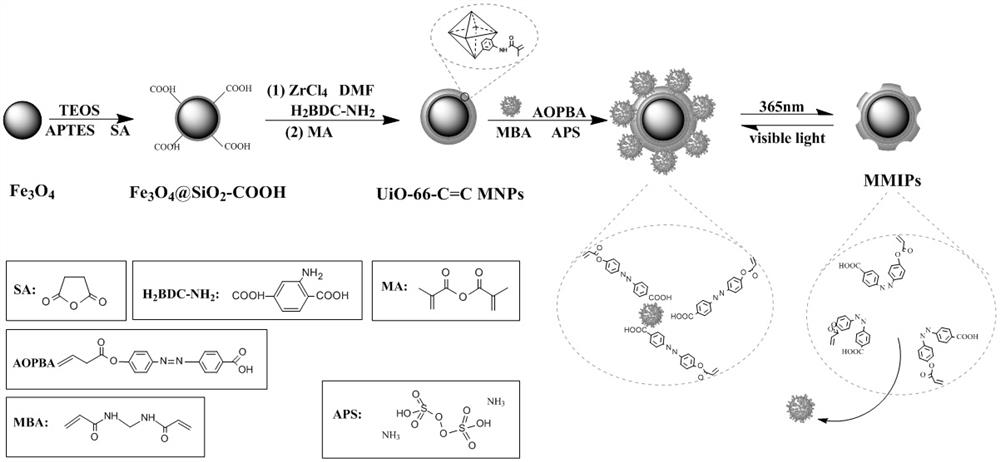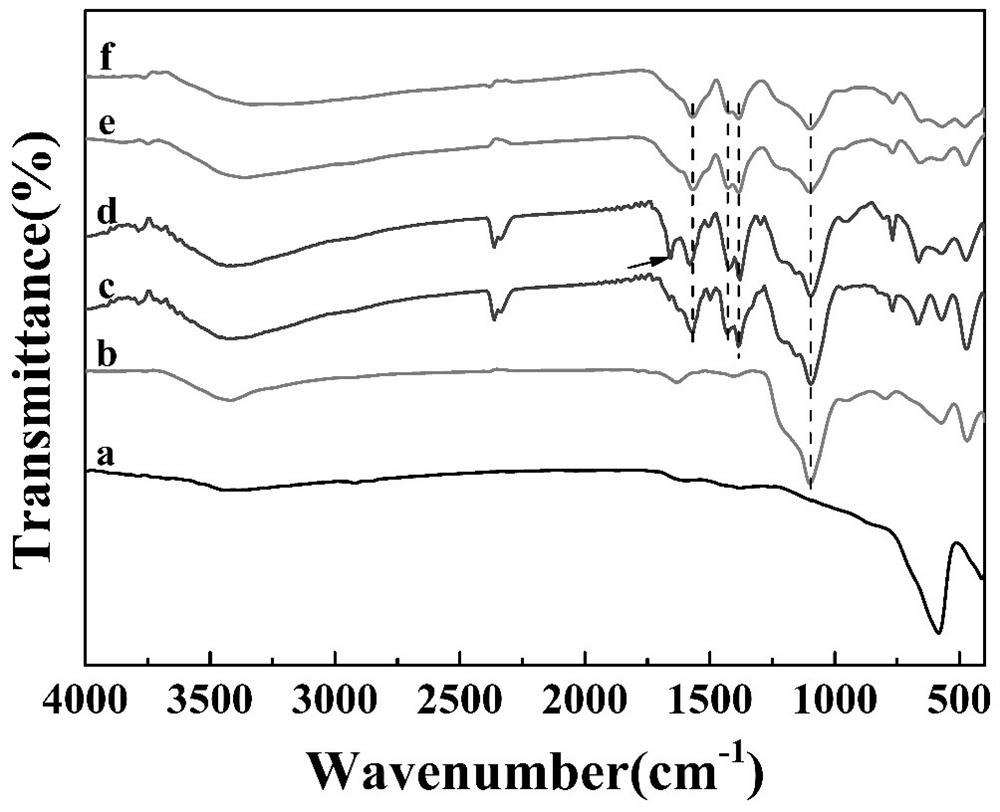Dual-response type virus molecularly imprinted sensor based on magnetism and photons, and construction method thereof
A dual-response, molecularly imprinted technology, applied in the field of analytical chemistry, can solve problems such as virus-imprinted polymers, and achieve fast binding kinetics, high adsorption capacity, and simple preparation process
- Summary
- Abstract
- Description
- Claims
- Application Information
AI Technical Summary
Problems solved by technology
Method used
Image
Examples
Embodiment 1
[0129] A novel method for the construction of a dual-response virus molecularly imprinted sensor based on magnetism and photonics, such as figure 1 shown, including the following steps:
[0130] (1) Fe 3 o 4 @SiO 2 Preparation of nanoparticles: 100 mL of isopropanol and 4 mL of ultrapure water (isopropanol: ultrapure water = 100:2~8) mixture was used as a solvent to prepare Fe 3 o 4 @SiO 2 Nanoparticles. First, 500 mg Fe 3 o 4 Nanoparticles (about 100-200 nm) were added to the mixture, and placed in an ultrasonic oscillator for ultrasonic treatment and dispersion for 20 minutes. Under mechanical stirring, 5 mL NH 3 ·H 2 O was added to the above mixture, and then 2 mL of tetraethyl orthosilicate (TEOS) was slowly added at a controlled rate (20 drops / min), and the reaction solution was placed at 45 °C for 6 hours. After the reaction was completed, the particles were collected with a magnet, washed several times with deionized water and ethanol in turn, and dried in a ...
Embodiment 2
[0138] Example 2: Characterization of the performance, morphology and structure of the MMIPs resonant photosensor and intermediate products
[0139] The structure and morphology of all the materials prepared in Example 1 were characterized by Fourier transform infrared spectrometer, X-ray diffractometer and scanning electron microscope. figure 2 for Fe 3 o 4 Particle (a), Fe 3 o 4 @SiO 2 -COOH particles (b), Fe 3 o 4 @SiO 2 @UiO-66-NH 2 Particle (c), Fe 3 o 4 @SiO 2 @UiO-66-NH 2 Infrared spectra of -C=C particles (d), MMIPs (e) and MNIPs (f) particles. about 582 cm -1 The absorption peak at is attributed to Fe 3 o 4 The characteristic peak of Fe-O; 1095 cm -1 The absorption peak at is the stretching vibration peak of Si-O-Si; 1635 cm -1 The peak at is attributed to the vibrational absorption of the C=O bond in the amide, indicating that APTES was successfully coated on the particle and modified -COOH from succinic anhydride; continued to modify UiO-66-NH 2 ...
Embodiment 3
[0142] Example 3: Application of the resonant optical molecular imprinting sensor
[0143] (1) The experimental conditions of this example are: the dosage of MMIPs is 90 ng / mL, the pH is 7.4, the adsorption time is 20 min, and the temperature is 25°C. The specific implementation is: take 5 U / mL EV71 and MMIPs in 90 ng / mL Tris-HCl buffer, adjust the pH of the whole system to 7.4, and measure the resonance light intensity after shaking and adsorbing at 25 °C for 20 min ; Then irradiate under 365nm ultraviolet light for 20 min, then measure the resonance light intensity, and then measure the resonance light intensity after 20 min irradiation under visible light.
[0144] (2) Detection and analysis of different concentrations of EV71 by MMIPs resonant light sensor
[0145] Under optimized conditions, the prepared MMIPs and MNIPs were used to detect and analyze different concentrations of EV71. Such as Figure 5 As shown in A, after adding different concentrations of EV71, the r...
PUM
| Property | Measurement | Unit |
|---|---|---|
| particle diameter | aaaaa | aaaaa |
Abstract
Description
Claims
Application Information
 Login to View More
Login to View More - R&D
- Intellectual Property
- Life Sciences
- Materials
- Tech Scout
- Unparalleled Data Quality
- Higher Quality Content
- 60% Fewer Hallucinations
Browse by: Latest US Patents, China's latest patents, Technical Efficacy Thesaurus, Application Domain, Technology Topic, Popular Technical Reports.
© 2025 PatSnap. All rights reserved.Legal|Privacy policy|Modern Slavery Act Transparency Statement|Sitemap|About US| Contact US: help@patsnap.com



